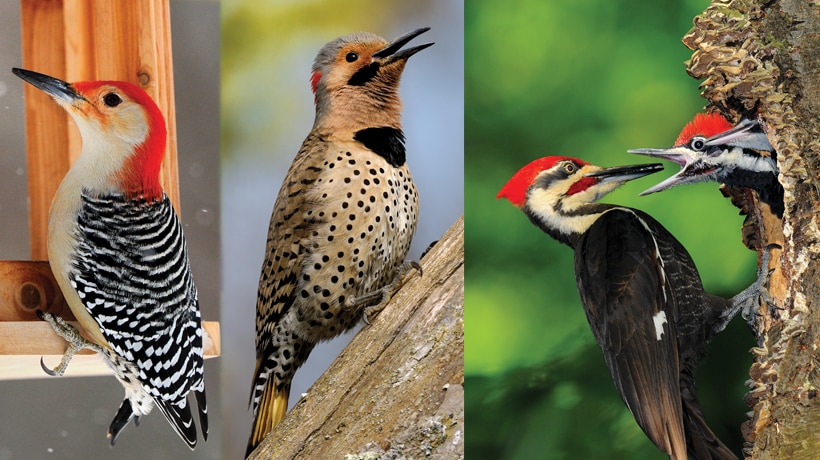Woodpeckers in Florida: Natural History, Ecology, and Conservation
Woodpeckers in Florida: Natural History, Ecology, and Conservation
Blog Article
Unveiling the Secrets of Woodpeckers: Actions, Habitat, and Extra
Woodpeckers, with their unique actions and specialized adjustments, have lengthy attracted scientists and nature enthusiasts alike. These remarkable birds have a range of appealing tricks that clarified their survival methods, environment choices, and elaborate interaction techniques. By revealing the secrets surrounding woodpeckers' behavior and environment choices, a deeper understanding of these avian wonders arises, supplying a glimpse into their fascinating globe. What makes these birds genuinely exceptional, and how do they browse their environment with such precision and skill? Allow's check out the exciting world of woodpeckers and unravel the enigmatic details that make them such fascinating subjects of research.
Woodpecker Actions Insights
In examining woodpecker actions, a fascinating display screen of specialized skills and adaptations arises, clarifying their exceptional eco-friendly particular niche - Woodpeckers in Florida. Woodpeckers, understood for their distinctive drumming on trees, have a variety of behavior characteristics that add to their survival and success in their setting. One vital actions is their drumming, which offers several purposes such as communication, establishing area, drawing in mates, and locating food sources. This rhythmic pecking additionally showcases their amazing stamina and endurance, as they can hammer away continuously at high rates without causing damage to themselves.
Additionally, woodpeckers exhibit a special feeding habits identified by their ability to extract insects from tree bark using their specialized beaks. Their lengthy, barbed tongues help in capturing prey, while their strong neck muscular tissues provide security and accuracy throughout pecking movements. This feeding technique enables woodpeckers to gain access to hidden insect larvae and extract them with amazing effectiveness.
Environment Preferences and Choice
What elements affect the habitat preferences and selection of woodpeckers? Woodpeckers are very adaptable birds understood to populate different settings worldwide. They do show choices for particular environment attributes. One important variable influencing woodpecker environment selection is the availability of suitable nesting sites. Woodpeckers normally like forests with a mix of fully grown trees that offer adequate chances for dental caries excavation. These tooth cavities act as essential nesting and roosting sites for woodpeckers and are vital for their reproducing success.
Additionally, woodpeckers reveal a preference for habitats with an abundant supply of food resources. They are primarily insectivorous, eating beetles, ants, larvae, and other bugs located in worn out wood or tree bark. Woodpeckers often tend to prefer woody locations with a diverse insect populace to meet their dietary requirements.
In addition, the presence of dead or find out this here rotting trees is one more key element in woodpecker environment choice. These trees not only supply food resources however likewise use appropriate substrate for tooth cavity excavation. Dead trees are essential for the upkeep of healthy woodpecker populations, as they play a vital role in the woodpeckers' life process and community characteristics.
Feeding Behaviors and Diet Regimen Composition
Woodpeckers demonstrate a specialized feeding habits concentrated on foraging for bugs within various habitats. Their diet plan mainly includes bugs such as beetles, ants, caterpillars, and spiders, which they find by touching on tree bark and paying attention for the audio of motion inside. Woodpeckers utilize their solid beaks to pierce into the wood and their lengthy, barbed tongues to draw out target from gaps. Along with insects, woodpeckers likewise take in tree sap, fruits, nuts, and seeds, adding variety to their diet regimen depending upon the season and schedule of food resources.
The foraging methods of woodpeckers are well-adapted to their arboreal way of life. Woodpeckers play an important duty in maintaining the wellness of woodlands by regulating insect populaces and assisting in the disintegration of wood.
Drumming Seems and Communication
Making use of quick drumming sounds on various surfaces, woodpeckers utilize a distinct kind of communication to indicate area borders and attract mates. This drumming habits is not only a means of communication however likewise works as a way for woodpeckers to develop their presence within a particular area. The intensity, rate, and pattern of the drumming can communicate crucial information to various other woodpeckers in the area.
Woodpeckers make use of drumming look at these guys noises to announce their existence in an area and to advise off possible trespassers. The loud and repetitive nature of the drumming functions as a clear signal to various other woodpeckers that the location is currently claimed. This aids in decreasing disputes and minimizing physical fights between individuals.

Survival Adaptations and Specialized Anatomy

Verdict
To conclude, woodpeckers display unique habits, such as drumming noises for interaction, and have actually specialized composition for survival in their chosen environments. Their feeding practices and diet structure additionally show their versatility to different environments. By recognizing these facets of woodpeckers, scientists and conservationists can better shield and protect these fascinating birds and their ecological communities.
Report this page